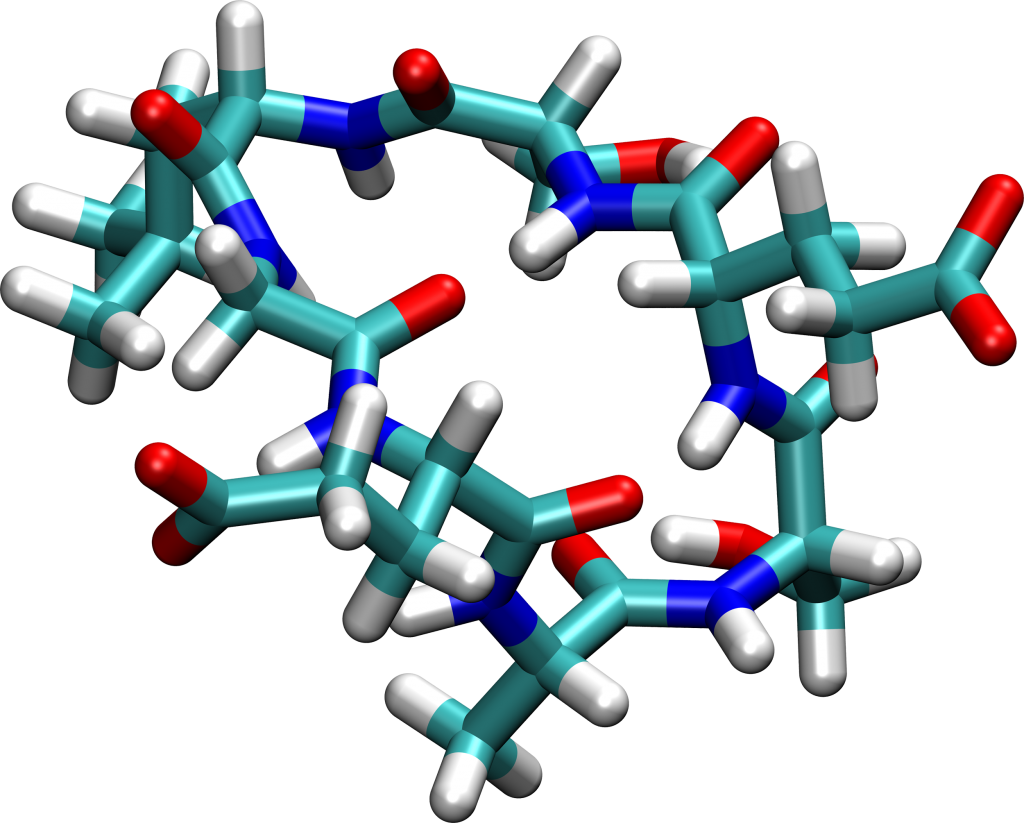Cyclic Peptides
The YSL Group seeks to model structure prediction for cyclic peptides using molecular dynamics simulations and enhanced sampling methods.


Related YSL Group Papers
L. Calvo-Barreiro,† M. Secor,† J. Damjanovic, S. A. Abdel-Rahman, Y.-S. Lin,* M. Gabr,* “Computational design of a bicyclic peptide inhibitor targeting the ICOS/ICOS-L protein–protein interaction,” Chem. Biol. Drug Des. 105, e70117 (2025).
†Equal contributions.
*Co-corresponding authors.
T. Hui,† M. Secor,† M. N. Ho,† N. Bayaraa, Y.-S. Lin, “Molecular dynamics (MD)-derived features for canonical and non-canonical amino acids,” J. Chem. Inf. Model. 65, 1837–1849 (2025).
†Equal contributions.
J. Miao, A. P. Ghosh, M. N. Ho, C. Li, X. Huang, B. L. Pentelute, J. D. Baleja, Y.-S. Lin, “Assessing the performance of peptide force fields for modeling the solution structural ensembles of cyclic peptides,” J. Phys. Chem. B 22, 5281–5292 (2024).
F. Fonseca-Lopez, J. Miao, J. Damjanovic, L. Bischof, M. Braun, Y. Ling, M. Hartmann, Y.-S. Lin,* J. A. Kritzer,* “Computational prediction of cyclic peptide structural ensembles and application to the design of Keap1 binders,” J. Chem. Inf. Model. 63, 6925–6937 (2023).
* Co-corresponding authors
T. Hui,† M. L. Descoteaux,† J. Miao,† Y.-S. Lin, “Training neural network models using molecular dynamics simulation results to efficiently predict cyclic hexapeptide structural ensembles,” J. Chem. Theory Comput. 19, 4757–4769 (2023).
†Equal contributions.
J. Miao, M. Descoteaux, Y.-S. Lin, “Structure prediction of cyclic peptides by molecular dynamics + machine learning,” Chem. Sci. 12, 14927–14936 (2021).
J. Damjanovic,† J. Miao,† H. Huang,† Y.-S. Lin, “Elucidating solution structures of cyclic peptides using molecular dynamics simulations,” Chem. Rev. 121, 2292–2324 (2021).
†Equal contributions.
H. Huang,† J. Damjanovic,† J. Miao, Y.-S. Lin, “Cyclic peptides: Backbone rigidification and capability of mimicking motifs at protein–protein interfaces,” Phys. Chem. Chem. Phys. 23, 607–616 (2021).
†Equal contributions.
A. E. Cummings,† J. Miao,† D. P. Slough, S. M. McHugh, J. A. Kritzer,* Y.-S. Lin,* “Beta-branched amino acids stabilize specific conformations of cyclic hexapeptides,” Biophys. J. 116, 433–444 (2019).
†Equal contributions. *Co-corresponding authors.
D. P. Slough,† S. M. McHugh,† A. E. Cummings, P. Dai, B. L. Pentelute, J. A. Kritzer, Y.-S. Lin, “Designing well-structured cyclic pentapeptides based on sequence—structure relationships,” J. Phys. Chem. B 122, 3908–3919 (2018).
†Equal contributions.
Y. Li, N. P. Lavey, J. A. Coker, J. E. Knobbe, D. C. Truong, H. Yu, Y.-S. Lin, S. L. Nimmo, A. S. Duerfeldt, “Consequences of depsipeptide substitution on the ClpP activation activity of antibacterial acyldepsipeptides,” ACS Med. Chem. Lett. 8, 1171–1176 (2017).
L. Peraro, Z. Zou, K. M. Makwana, A. E. Cummings, H. L. Ball, H. Yu, Y.-S. Lin, B. Levine, J. Kritzer, “Diversity-oriented stapling yields intrinsically cell-penetrant inducers of autophagy,” J. Am. Chem. Soc. 139, 7792–7802 (2017).
D. P. Slough, H. Yu, S. M. McHugh, Y.-S. Lin, “Toward accurately modeling N-methylated cyclic peptides,” Phys. Chem. Chem. Phys. 19, 5377–5388 (2017).
S. M. McHugh,† H. Yu,† D. P. Slough, Y.-S. Lin, “Mapping the sequence—structure relationships of simple cyclic hexapeptides,” Phys. Chem. Chem. Phys. 19, 3315–3324 (2017).
†Equal contributions.
S. M. McHugh,† J. R. Rogers,† S. A. Solomon,† H. Yu,† Y.-S. Lin, “Computational methods to design cyclic peptides,” Curr. Opin. Chem. Biol. 34, 95–102 (2016).
S. M. McHugh,† J. R. Rogers,† H. Yu, Y.-S. Lin, “Insights into how cyclic peptides switch conformations,” J. Chem. Theory Comput. 12, 2480–2488 (2016).
†Equal contributions.
H. Yu and Y.-S. Lin, “Toward structure prediction of cyclic peptides,” Phys. Chem. Chem. Phys. 17, 4210–4219 (2015).
J. S. Quartararo, M. R. Eshelman, L. Peraro, H. Yu, J. D. Baleja, Y.-S. Lin, J. A. Kritzer, “A bicyclic peptide scaffold promotes phosphotyrosine mimicry and cellular uptake,” Bioorg. Med. Chem. 22, 6387–6391 (2014).
Y. Zou, A. M. Spokoyny, C. Zhang, M. D. Simon, H. Yu, Y.-S. Lin, B. L. Pentelute, “Convergent diversity-oriented side-chain macrocyclization scan for unprotected polypeptides,” Org. Biomol. Chem. 12, 566–573 (2014).
A. M. Spokoyny, Y. Zou, J. J. Ling, H. Yu, Y.-S. Lin, B. L. Pentelute, “A perfluoroaryl-cysteine SNAr chemistry approach to unprotected peptide stapling,” J. Am. Chem. Soc. 135, 5946–5949 (2013).
